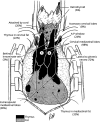Does Surgical Removal of the Thymus Have Deleterious Consequences?
- PMID: 38781559
- PMCID: PMC11226319
- DOI: 10.1212/WNL.0000000000209482
Does Surgical Removal of the Thymus Have Deleterious Consequences?
Abstract
The role of immunosenescence, particularly the natural process of thymic involution during aging, is increasingly acknowledged as a factor contributing to the development of autoimmune diseases and cancer. Recently, a concern has been raised about deleterious consequences of the surgical removal of thymic tissue, including for patients who undergo thymectomy for myasthenia gravis (MG) or resection of a thymoma. This review adopts a multidisciplinary approach to scrutinize the evidence concerning the long-term risks of cancer and autoimmunity postthymectomy. We conclude that for patients with acetylcholine receptor antibody-positive MG and those diagnosed with thymoma, the removal of the thymus offers prominent benefits that well outweigh the potential risks. However, incidental removal of thymic tissue during other thoracic surgeries should be minimized whenever feasible.
Conflict of interest statement
H.J. Kaminski is principal investigator for the Rare Disease Network (MGNet supported by NIH grant U54NS115054) is a consultant for R43NS12432, Roche, Takeda, Cabaletta Bio, UCB Pharmaceuticals, Canopy EMD Serono, Ono Pharmaceuticals, ECoR1, Gilde Healthcare, and Admirix, Inc., has received research support from Argenix (paid to institution), and has equity interest in Mimivax, LLC, and has equity interest in Mimivax, LLC, and serves as a consultant for GRO Biotechnology, CSL Berhing, Amplo Biotechnology, and Sanofi. G.I. Wolfe has served as vice chair for the International Treatment Consensus panel (funded by the Myasthenia Gravis Foundation of America). The other authors report no relevant disclosures. Go to
Figures


References
Publication types
MeSH terms
LinkOut - more resources
Full Text Sources
Medical
